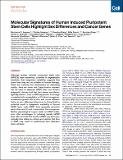Molecular Signatures of Human Induced Pluripotent Stem Cells Highlight Sex Differences and Cancer Genes
Author(s)
Anguera, Montserrat C.; Sadreyev, Ruslan; Zhang, Zhaoqing; Szanto, Attila; Payer, Bernhard; Sheridan, Steven D.; Kwok, Showming; Haggarty, Stephen J.; Sur, Mriganka; Alvarez, Jason; Gimelbrant, Alexander A.; Mitalipova, Maisam; Kirby, James E.; Lee, Jeannie T.; ... Show more Show less
DownloadAnguera-2012-Molecular Signatures.pdf (3.111Mb)
PUBLISHER_POLICY
Publisher Policy
Article is made available in accordance with the publisher's policy and may be subject to US copyright law. Please refer to the publisher's site for terms of use.
Terms of use
Metadata
Show full item recordAbstract
Although human induced pluripotent stem cells (hiPSCs) have enormous potential in regenerative medicine, their epigenetic variability suggests that some lines may not be suitable for human therapy. There are currently few benchmarks for assessing quality. Here we show that X-inactivation markers can be used to separate hiPSC lines into distinct epigenetic classes and that the classes are phenotypically distinct. Loss of XIST expression is strongly correlated with upregulation of X-linked oncogenes, accelerated growth rate in vitro, and poorer differentiation in vivo. Whereas differences in X-inactivation potential result in epigenetic variability of female hiPSC lines, male hiPSC lines generally resemble each other and do not overexpress the oncogenes. Neither physiological oxygen levels nor HDAC inhibitors offer advantages to culturing female hiPSC lines. We conclude that female hiPSCs may be epigenetically less stable in culture and caution that loss of XIST may result in qualitatively less desirable stem cell lines.
Date issued
2012-07Department
Massachusetts Institute of Technology. Department of Brain and Cognitive Sciences; Picower Institute for Learning and MemoryJournal
Cell Stem Cell
Publisher
Elsevier B.V.
Citation
Anguera, Montserrat C., Ruslan Sadreyev, Zhaoqing Zhang, Attila Szanto, Bernhard Payer, Steven D. Sheridan, Showming Kwok, et al. “Molecular Signatures of Human Induced Pluripotent Stem Cells Highlight Sex Differences and Cancer Genes.” Cell Stem Cell 11, no. 1 (July 2012): 75–90. © 2012 Elsevier Inc.
Version: Final published version
ISSN
19345909